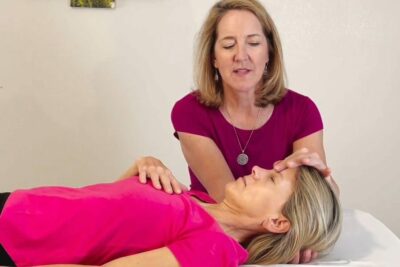POSTPARTUM CASE STUDY: Pelvic Pain Plus
POSTPARTUM CASE STUDY: Pelvic Pain Plus
Introduction: This case study is a perfect example of why we must address the pelvis’s open birthing pattern.
You may be wondering why I called this case study Pelvic Pain Plus. It has to do with this client’s complaints when she saw me for the first time.
Client History: Sara (not her real name) came to see me 20 months after the birth of her second child. Her first child was 26 y/o, and she had an uncomplicated birth and recovery with him. She reported that with her second pregnancy, she developed pelvic pain around 5-6 months and was debilitated at 7 months, where she couldn’t move and had stabbing vaginal pains. Her husband had to help her get around the house.
She described an extremely painful and traumatic birth where she disassociated as the epidural did not touch her pain. The baby was born vaginally while she was on her back, where she struggled to support her one leg and her husband held the other.
Since her second birth, she has had difficulty walking, pain with bearing weight through her legs, and complains of pain in all her joints bilaterally: ankles, knees, pelvis, lower back, elbows, wrists, and fingers. Every joint except her shoulders. She also reported she had two rounds of antibiotics for severe mastitis and could not breastfeed her baby. She was upset when she learned the baby had a tongue tie.
I don’t know about you, but this kind of presentation and the mastitis had me thinking of some systemic issue in her body causing all this pain. She had been tested by several doctors and had multiple MRIs, and they couldn’t find anything.
So I did what I do best, and I listened to her body!
Assessment and Findings: I was immediately drawn to the client’s pelvis. She was very tender in her PSISs and at her sacral base. I found her sacrum to be stuck in flexion with a right deviation similar to the common birth pattern. Both her ischiums were splayed, but her right was more so.
Treatment: I gently mobilized her bones out of these patterns and here is where the pelvic plain plus comes in. I got about halfway there with the mobilization of her bones when my intuition pulled me to her dural tube.
The dural tube is the connective tissue surrounding the brain and spinal cord and surrounds every nerve as it exits the spinal column. It has several attachment points, but good handles for working with it are at the occipital and sacral bases. I found hers to be extremely tight, compressed, and restricted, mainly on the right side. There was a beautiful softening and lengthening of this tissue, and afterward, I was drawn to work with more of her central nervous system. These techniques are taught in my online Advanced Postpartum Techniques course.
After her nervous system was more settled and she had a release of several bouts of emotional tears, I was again drawn back to her pelvis. Now, I could fully release her pelvic bones and bring them to their original position.
As her session ended, I had her do some gentle pelvic tilts, and she was amazed it didn’t hurt. I had her move her feet, then her knees, and again, no pain. Her arms, too, had no pain. She carefully got up off the table and was shocked it didn’t hurt. I taught her how to do the exercises to close up her pelvic bones so she could continue independently. As she stood cautiously testing out weight-bearing movements with her body, she kept waiting for the pain to come, but it didn’t.
Client Outcome: I reached out to her the next day to check in, and she reported she has been doing more physical movement than she had in over 2 years. She felt pretty good!
I was just as surprised as she was about this outcome. I believe the dural tube release and pelvic bone mobilizations were critical for this result. This shows that the unstable pelvis, her foundation, impacted many of her difficulties with movements and weight bearing and the dural tube restriction may have exacerbated the pain in all her joints. She is ecstatic to be feeling better.
Want to Learn the Techniques Used to Treat Pelvic Pain Plus: To learn more about how to release the Open Birthing Pattern and additional postpartum patterns join the waitlist for Treating the Postpartum Pelvis, an online course coming end of September 2023. In 3 hours of coursework, you will know how to assess and treat 3 of the most common postpartum patterns and be able to confidently treat your postpartum clients. If you have taken the Holistic Treatment of the Postpartum Body then you can sign up for the Advanced Postpartum Techniques course to learn how to work with the central nervous system as well as other techniques for the postpartum body.
About the Author: Lynn Schulte is a Pelvic Health Therapist and the founder of the Institute for Birth Healing, a pelvic health continuing education organization that specializes in prenatal and postpartum care. For more information, go to https://instituteforbirthhealing.com

